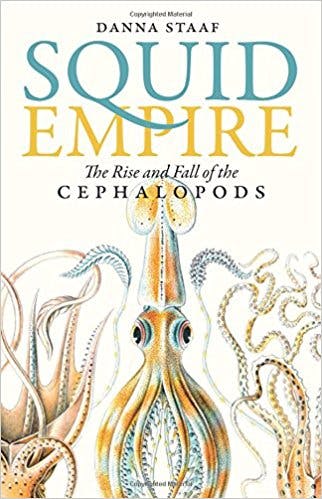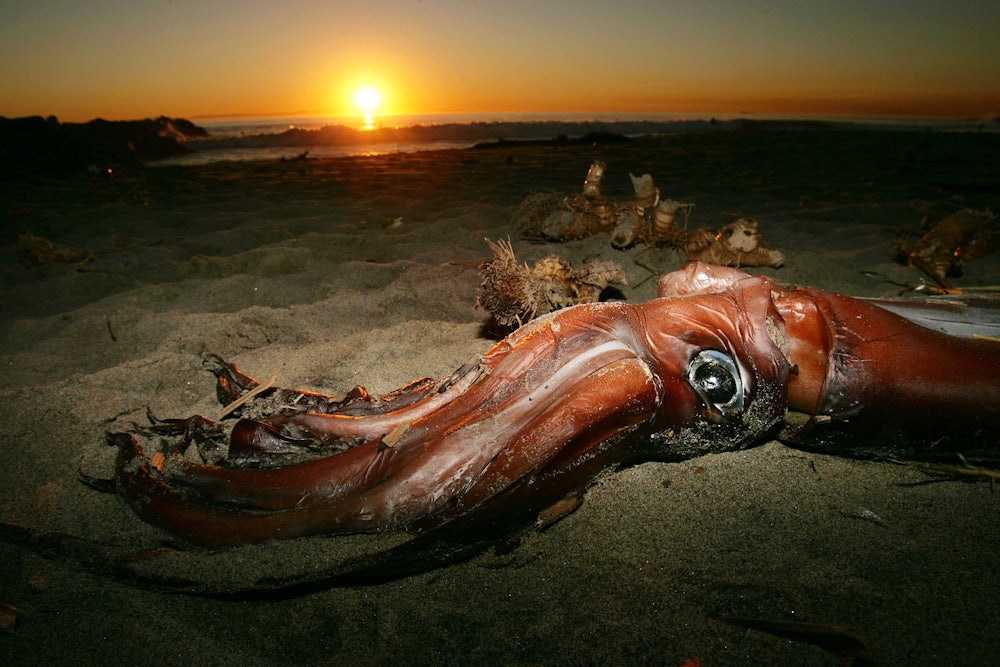In the wake of the Battle of Little Big Horn, U.S. soldiers confiscated a number of strange rocks from their captives’ medicine pouches. Etched with lines that resembled outlines of buffalos, the rocks were sacred to the Blackfoot and other plains Indians, who used them to draw buffalo herds over cliffs. But, it turned out, they were not actually stones at all. They were the fossilized shells of ammonoids, a great race of cephalopods (distantly related to the nautilus) that once roamed the seas. For all the cultural significance humans gave the fossils, we know very little about the ammonoids themselves: how they acted, felt, communicated. We know they did not call to buffalo, but we’re at a loss as to whom they did call.

Danna Staaf’s Squid Empire: The Rise and Fall of the Cephalopods, tells the story of the world of ancient cephalopods—at least, as best anyone can—including these ammonoids. Cephalopods, which include octopi, cuttlefish, and squid, belong to the Mollusca phylum, are chiefly identified by their tentacles. Today’s species can outswim the fastest Olympians, change color at will, escape through the tiniest of holes. And they are fabulous communicators. A cuttlefish, for example, can carry on multiple visual conversations at once: A male courting a female will display a sexy, striped pattern on the side of his body facing the female, while the other side of his body will mimic a female’s mottled pattern, tricking a nearby rival into thinking he was another female and thus not a threat. Cuttlefish, apparently, won’t do this if multiple males are nearby—it’s too difficult to deceive multiple rivals, and they do not want to get caught lying, a fact that further suggests their extreme intelligence.
Cephalopods are also essential to understanding the broader web of life on Earth. Humboldt squid are a so-called “keystone species” in the Pacific: An entire ecosystem depends on them (a single sperm whale can eat 700 to 800 squid every single day). “They start so small, grow so fast, and get so big,” Staaf writes, “that they provide abundant food for marine predators of every size—a ‘one-prey-fits-all’ solution. Thus, many species of squid act as biological conveyor belts, moving energy from tiny plankton up to apex predators, including humans.”
Cephalopods have long been innovators, starting several hundred million years ago, when they reinvented the shell. Other mollusks had developed shells—think snails and clams, for example. But the cephalopod sealed off its shells (either through chambers, or a thin layer of tissue that worked to replace water with gas), creating buoyancy and allowing for faster movement. “A buoyant shell was the key innovation of cephalopods,” Staaf explains, putting it even above their dazzling light displays and physical feats. “It constituted a total transformation of the mollusk body plan, turning crawlers and oozers into floaters and swimmers.” And while this feature persists in the nautilus and a few other remaining species, subsequent cephalopods eventually shed their shells. Many predators rely on echolocation to find prey, and those echoes bounce off of shells clear as a bell, making the creature easier to find. By contrast, squishier, fleshier animals, like octopi and squid, tend to absorb those echoes, or at least mute them, making them harder to track for whales and dolphins.
During the Paleozoic and Mesozoic eras, cephalopods dominated the seas. Voracious and omnivorous predators, wildly adaptable survivors, cephalopods were far more numerous, and their reign lasted longer, than the dinosaurs. They survived an even greater extinction event: the Permian Extinction, when volcanoes in Siberia erupted for a solid 100,000 years, blotting out nearly 96 percent of all marine life. And yet we know far less about them. Why?
The main reason, it would seem, why these august cephalopods seem to have eluded our imagination is simply because many of them left behind very little in the fossil record. “A soft body,” Staaf notes, “is far less likely to fossilize than a hard shell.” We have known about fossilized ammonoids and nautiloids at least since ancient Greece (though many—including Pliny the Elder, who gave ammonoids their name—thought they were precious gems), but it wasn’t until 1883 that a fossilized octopus was discovered and catalogued.
Squid, in particular, are difficult to find in the fossil record. “The critical component of high-quality octopus fossils seems to be phosphate,” Staaf explains,
a chemical that occurs naturally in seawater, and in living tissue as a building block of DNA and of energy-carrying molecules. When conditions are right, the soft tissues of a dead animal can quickly be replaced with the mineral calcium phosphate. Such phosphatic fossilization sometimes preserves detail down to the level of single cells.
But squids use ammonia for buoyancy, and ammonia inhibits this calcification, preventing any fossilization until the squid’s body has decomposed. While this ammonia component was crucial to their development and survival, it means that many left behind no trace in the geological world. As one scientist put it, “They basically evolved themselves out of the fossil record.” Not unlike Inky the Octopus, who escaped from his tank in the National Aquarium of New Zealand in 2016, ancient squids have effected their own escape trick, slipping out of the historical record.
What cephalopods mostly do leave behind is their shells, which often provide just glimpses of a life, and are much harder to decode than a vertebrate’s skeletal system. Writing on the history of ammonoids, Neale Monks commented that “Vertebrate bones have an intimate relationship with the muscles connected to them. Looking at the skeleton of a dinosaur or mammoth tells you a great deal about how the animal was put together and what it looked like in life. By contrast, the shell of an ammonite is mute.”
The fact that so much remains unknown has led to fervent arguments among those trying to reconstruct the world of long-gone cephalopods. The extinct scaphites, for example, have long puzzled marine biologists. With “paper-clip” shaped shells, the animals’ habits have been subject to much debate. Some argued that their bodies filled up the entire shell, while others maintained that they were smaller, and moved within their shells as though they were portable caves. The paper-clip shape suggested to some that when they reached adulthood they attached themselves to stationary seaweed. But others maintain that the unique structure was purely a defensive mechanism that allowed the small creature to retreat into its shell in a way that left it inaccessible to predators. If so, then, scaphites likely didn’t have big, long arms or a strong siphon for jet propulsion; they probably drifted along, gathering up plankton and other defenseless marine life. But because all we have is the shell, it’s hard to know for sure what they did or exactly how they did it.
These feats of deduction and induction are a reminder that the true protagonists of Squid Empire are not the cephalopods, but the scientists who work on them. Ultimately, Staaf is telling their story, not that of their tentacled-subjects. For each unequivocal fact or hypothesis about how these ancient cephalopods lived, there is a litany of names, of biologists and archeologists who’ve toiled tirelessly and inventively to understand these mysterious ancestors. The battles she describes here are not on the ocean floor amongst extinct creatures fighting for food, but in the lab and in scientific journals, as rival scientists’ jockey for their own theories’ acceptance.
A book like Squid Empire is a reminder that in any scientific narrative, there are always two stories at play. There is the history of the subject you’re studying, and then there is the history of its discovery. A constant difficulty of any science writer is to give both stories their due, particularly since each has its own chronology and pace. Too often, however, we end up prioritizing the latter, telling a story of human ingenuity and technology, while the world itself—filled with its wonders and strangeness—is reduced to merely the backdrop.
Cephalopods present perhaps a more striking version of this dilemma than other animals, because they are so obviously intelligent, and so completely unlike us. There are other animals whose intelligence likely rivals our own: elephants, dolphins, primates, whales, dogs. But these are all vertebrate mammals, and their reasoning, to different degrees, often mirrors our own. Cephalopods are wonderfully alien, and how their intelligence works is even more of a mystery. Their brains are tripartite: They have an optic lobe behind each eye, each connected to a central ring of nervous tissue through which their esophagus runs. Even about living cephalopods, so much is unknown; their extinct ancestors who left behind hardly a trace lie across an even greater abyss of our own ignorance.
As such, their feats of intelligence tend to get reduced to factoids. And Squid Empire is of course full of such fun facts. But we are a long way off yet from understanding fully how the “empire” in Squid Empire functioned: how these amazing creatures built their societies, however unlike our own they may have been. And we are still a long way off from truly understanding how to listen to the call of the ammonoid.
